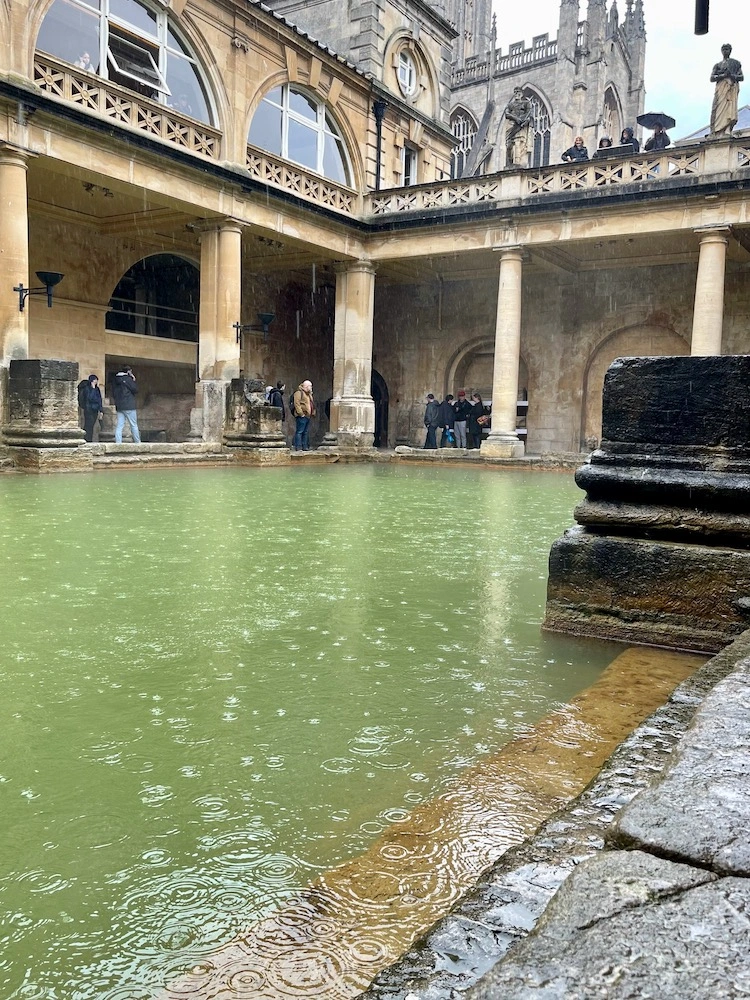5 Tips and Highlights from our visit to the Roman Baths in Bath, England
On our recent visit to the UK, 007 and I had the opportunity to visit the Roman Baths in Bath, England. The rain that day was a steady sprinkle and added to the ambience of the tour. Watching the ripples of the rain on the great bath transported me back to ancient days when rainfall was the source of the hot springs.

We both love history and are amazed by what we learn during our travels about ancient civilizations. The visit to the Roman Baths was rich in architecture, culture and history. Rome occupied Britain almost 2,000 years ago and it was fascinating to immerse ourselves in the lives of those who bathed here so many centuries ago. Here are a few tips and highlights.
1. Dedication of the Temple
The baths and all the buildings surrounding the springs were originally a temple dedicated to the goddess Sulis. I entered the structure thinking that it was simply a place for public bathing for the people of the ancient town. I imagined ladies with their children cooling off on hot days, but then I learned that it was quite the opposite. I was fascinated to learn it was a religious place. The water was warm and the purpose was for cleansing, worship and to my surprise, cursing!


2. Curse tablets found around the baths
It struck me as a little funny that during the excavation of the Baths, they found “curse tablets” that people had written and brought to the temple. The purpose was asking the goddess to intervene in some small infraction where someone may have stolen something from the writer and gotten away with it. They asked the goddess to curse them. They wrote these on tin, lead or copper pieces and placed them in various temples, according to which god they were appealing to. These would have been placed to plead with the Goddess Sulis to curse their enemies.
As I learn about various religions, I compare these things to my own faith. I remembered while reading about these curses that Jesus taught us to forgive 70 x 7 times. Peter wanted to know if there was a magic number where he could have permission to hold a grudge after so many infractions. I know the feeling. I had to chuckle at my own thoughts of political figures I’d like to curse today. Oh the names I thought of inscribing on pieces of paper and stuffing into the walls! 😂 But, then I remembered the wailing wall in Jerusalem and thought how much better it feels to prayer for my enemies than to curse them in the temple of a false god.
The curses were written in a type of cursive. I wondered if this is where “cursive” came from, kind of like Italic came from Italy? Don’t worry, I didn’t leave any curses.
3. The architecture and craftsmanship is a marvel
The columns, pediments from the surrounding structures and the statues have been beautifully preserved giving a surreal experience of walking through history. Ruins always fascinate me. How in the world did they transport the large stones or columns from quarries; how did they hoist them to such heights without cranes? It is truly marvelous to think about.
The above pediment is of the god, Gorgon, which reminded me of the commandment not to worship any graven images. These are things I think about while touring ancient sites. How so many things are interwoven from one culture to another. Even opposite things like this. The Romans and Greeks built lots of statues and had graven images of lots of gods. Our God knew we’d never even come close to His likeness and it’s not the image we worship anyway. It’s His Being.
We walked around the second level where there’s a beautiful view of the baths below and the Abbey that towers overhead next door. Everyone experiences these places differently, but I couldn’t help but think how we are taught to be baptized like Christ was baptized by John. Here we have miraculous springs bubbling out of the earth He created, dedicated to a false god; while right next door, years later a priest would consecrate his parishioners with holy water.


4. Coronation Day
We planned this trip long before Queen Elizabeth II died, so we had no idea that our visit to Bath would be the same day of the coronation of King Charles III. The highlight of the tour for me was when the coronation bells in the Bath Abbey began ringing while we were touring the bath. It was beautiful to hear.
Once again, because of my personal faith, I was reminded that Jesus is the King of all Kings – including King Charles III. Someday, instead of coronation church bells, there will be trumpets that proclaim this and just as I was looking up toward the tower, I hope I’m caught looking up toward the return of my Savior.
Those with different faiths will not tour the baths and come away with the same thoughts that I did. I was reminded at every turn how much I appreciate the architecture and structure of these and so many buildings that still stand today from ancient times. I am fascinated at man’s ability and with their search for something bigger than themselves. It seems civilizations from centuries ago along with ours today continue to search for meaning and purpose. And yes, even curses on the heads of their enemies.
As we travel the world (before we are too old to do so anymore), I am amazed at His creation. It reminds me again and again of what my purpose is and how my faith helps me understand about the meaning of life. It is simply this. To worship Him. Maybe that seems mundane or trivial to some, but when I think of how big our God is, it makes perfect sense to me. Worship in spirit and in truth for it is true worshippers the Father seeks. John 4:23-24.
I’d love to hear what you think about as you tour ancient ruins. As you plan your tour of the Roman Baths, here are a few logistical thoughts and tips:
5. Recommendations and Tips
- Go early in the day. The crowds will be smaller, giving you a great opportunity for photos without as many people in your shots.
- Buy your tickets ahead of time. It gets you through the line quicker.
- Plan on at least 2 hours to go through the baths.
- If possible, plan your tour with Sue Norris, from Bath Parade Guides. While tour guides are not permitted to tell you about the structures inside, Sue did a fabulous job of pointing out certain points we didn’t want to miss in the audio tour. We had a four hour walking tour with her including the tour of the Bath, that was informative, fun and insightful. She suggested we take the time to visit the Thermae Spa just around the corner from the Roman Baths.
- Don’t skip the Thermae Spa that is right next door. While you can’t take a dip in the actual Roman Bath site, you can have a delightful experience at the spa around the corner. The pool downstairs is warm and the surroundings are beautiful. The rooftop pool is a don’t miss experience! It was the highlight of our time in Bath. Be sure to pack a swimsuit.
- The locker rooms, toilets and changing rooms are top notch. They even have hair dryers and a swimsuit dryer so you won’t walk around with soppy wet clothing in your bag when you leave.
- Photos are not allowed for privacy reasons within the Thermae Spa. They provide a “locking device” to hold your phone while you visit. They unlock it when you exit. Your phone never leaves your possession, but you just can’t use it while “bathing”.
Be sure to visit this remarkable historical site while in the United Kingdom. It is well worth the effort. I enjoyed connecting with history, admiring the architecture and all the reminders of how we can learn something from previous civilizations.
For me personally, I loved all the ways I was challenged in my faith and felt prompted to pray and worship my God in a pagan temple. Elijah prayed and rained down fire to destroy the false prophets. It rained, but it was peaceful and as far as I know, nothing was destroyed.
Other Visits on this United Kingdom Tour include:

